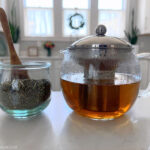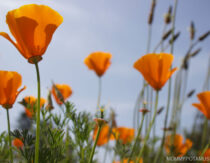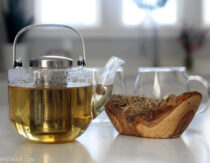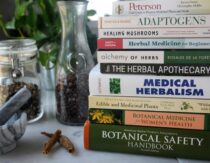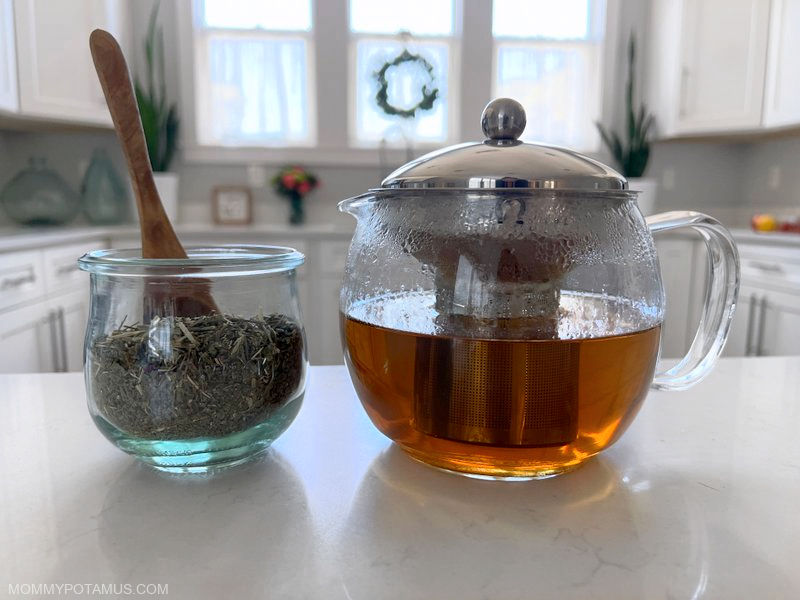
With a long, straight stem and clusters of tiny blueish-purple flowers, blue vervain is a valuable nervous system ally that thrives in wet meadows, river bottomlands, and other moisture-rich areas throughout the United States.
Though it’s not very well known these days, back in 1875 Dr. Oliver Phelps Brown wrote that “A more valuable plant is not found within the whole range of the Herbal Pharmacopoeia.” (1)
Like passionflower, lemon balm, catnip, and California poppy, it’s classified as a relaxing nervine – an herb that helps relax the mind and body. However, it has several other traditional uses, too, including cold and flu support, digestive support, sleep support, and detoxification.
We’ll dive into all that below, but first I want to remind you that that none of these statements have been evaluated by the FDA, this article is not medical advice, and it’s not meant to diagnose or treat any condition. If you have a question about whether any herb or dietary supplement is right for you, please talk with a qualified healthcare professional. Okay, let’s dive in!
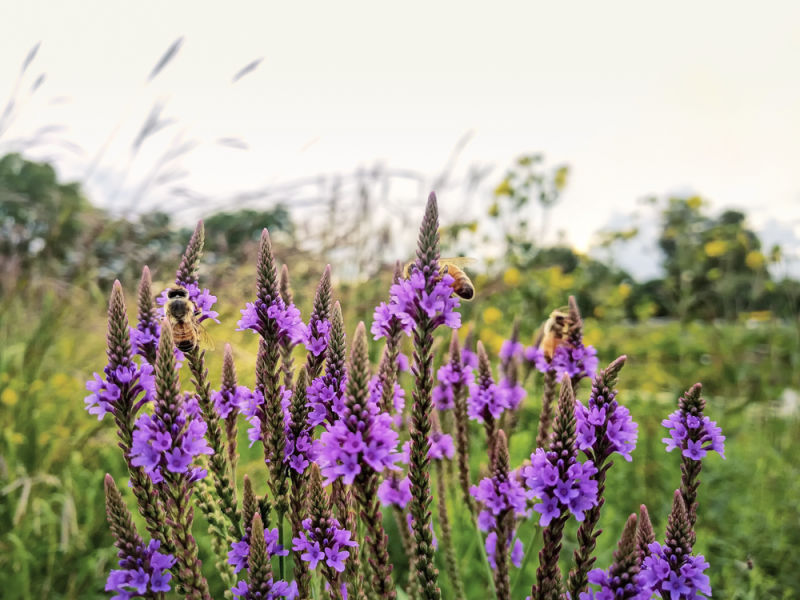
What is blue vervain?
Most herbs are called by a few different names, but blue vervain (Verbena hastata) answers to many: common verbena, Juno’s tears, wild hyssop, enchanter’s plant, herb of grace, herb of the cross, pigeon’s grass, simpler’s joy, swamp verbena, American blue vervain, and many more. (2)
It’s important to note that American blue vervain (Verbena hastata) is different from common vervain (Verbena officinalis), which is native to Europe, and white vervain (Verbena urticifolia), which is native to North America. They’re all used therapeutically and there is quite a bit of overlap in their benefits, but there are also some differences and the benefits we’ll cover below specifically relate to blue vervain.
Blue vervain is collected in the summer just before the buds open. The leaves and unopened buds are both used in herbal remedies, and research has identified several plant compounds that contribute to their beneficial properties:
- Bitter glycosides and iridoids including verbenalin, verbenin, and bastatoside
- Essential oils
- Mucilage
- Tannins
- Flavonoids (3) (4)
Here’s an overview of blue vervain’s traditional uses, plus the modern research that supports them.
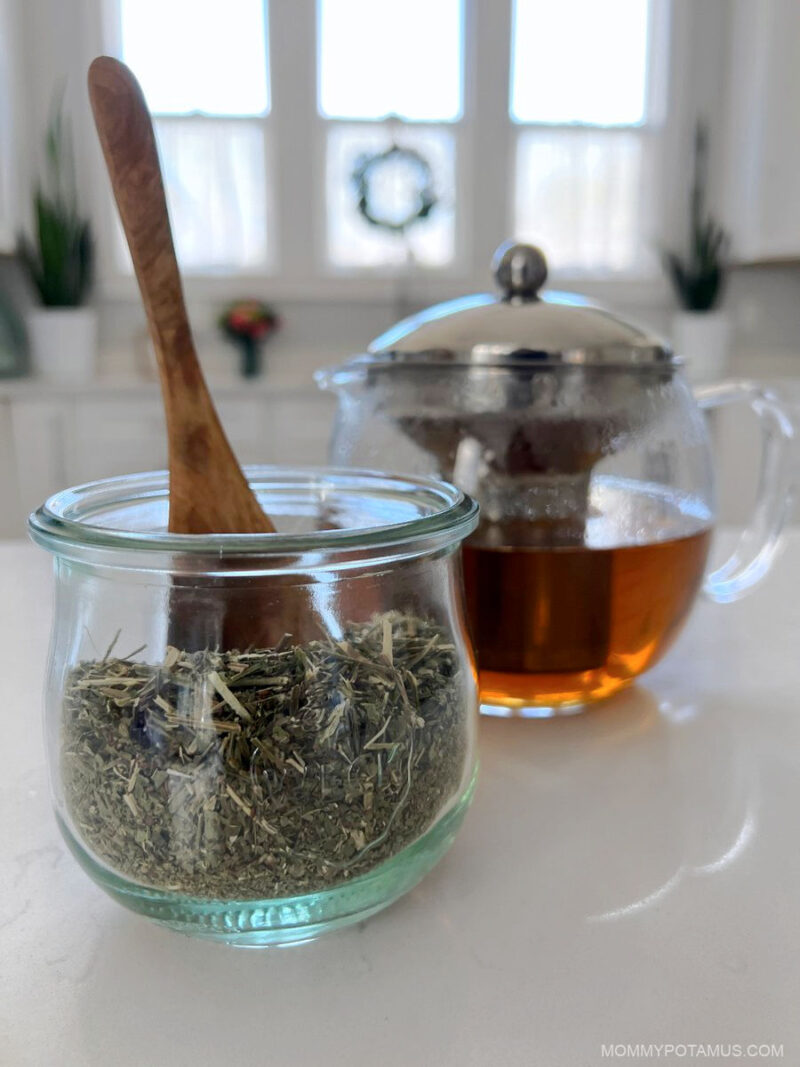
1. Relaxes The Nervous System
Blue vervain is classified as a nervine, which is an herb that relaxes, soothes and supports the nervous system. It’s relaxing properties are thought mostly to be due to an iridoid glycoside called verbenalin, and it is often recommended for easing general tension and stress. (5)
It’s also considered helpful for people who:
- Have “Type A” personalities, with high expectations of themselves and others
- Are experiencing burnout from long-term stress
- Tend to be inflexible (but would like to be able to “go with the flow” more often)
- Are dealing with feelings of worry or anxiousness (2)
Because herbs tend to work synergistically together, blue vervain is often blended with other calming herbs such as valerian root, linden, skullcap, and motherwort. (1)
2. Supports Deep Sleep
One of the longest-standing traditional uses of blue vervain is to support restful sleep. Though most of the research on this subject has been done with common vervain (Verbena officinalis), the two compounds that are thought to contribute to sleep promotion – hastatoside and vervenalin – are also found in blue vervain. (5) (6)
In one animal study done with common vervain, rats who received vervain extract 3-5 hours before bedtime showed an increase in non-rapid eye movement (NREM) sleep, especially delta wave (deep) sleep. (6)
In another study done specifically with blue vervain, rats who received a water extract fell asleep faster and stayed asleep longer than the control group. (7)
3.Supports Strong Digestion
Blue vervain is very bitter, which is not generally a flavor most of us seek out. However, it serves an important purpose: When our taste buds detect bitter compounds, they “recognize the taste as being potentially poisonous. As a result . . . our systems go into full alert and digestive juices start flowing in order to mitigate any poisons entering our system.” (8)
In other words, the bitter compounds in some herbs get our digestive systems all revved up, which increases the flow of stomach acid (HCl), bile, and enzymes so that we can break down and absorb nutrients.
When using blue vervain to support digestion, Making Plant Medicine author Richo Cech suggests taking it 15-20 minutes before meals. (9)
4. Supports Detoxification
The bitter compounds in blue vervain also help optimize our natural detoxification processes. Specifically, they stimulate the flow of fresh bile, which plays a role in both fat digestion and toxin elimination. Here’s how:
- In Phase I and II of liver detoxification, the liver converts fat soluble toxins into water soluble ones
- The toxins then flow into our urine to be eliminated OR they bind with bile and then are dragged out of the body via stool
That’s how it’s supposed to work, at least. When our gallbladder isn’t making a lot of bile, our bodies will actually recycle it to use later . . . and when that happens, we reabsorb some of the toxins that have been “caught” by the bile instead of flushing them out via the digestive tract.
By encouraging the flow of fresh bile, bitter compounds support our liver’s process of eliminating toxins. Click here to read more about how our detox systems work.
5. Breastfeeding Support
Blue vervain is not considered a galactogogue, or herb that directly increases milk supply. However, it has a long history of use for lactation support. According to JJ Pursell, author of The Herbal Apothecary, that’s because “New mothers are often under significant stress, which can result in a lack of milk production. Blue vervain helps reduce tension and improve milk flow.” (2)
Other Traditional Uses
- The tea or tincture is traditionally taken to support the sweating/fever process during a cold or flu (9)
- It was also used to ease discomfort associated with coughs
- According to JJ Pursell, “Blue vervain has been used for centuries as an excellent women’s herb. Those suffering from hot flashes will benefit from its cooling astringent properties.” (2) She adds that it may help ease symptoms of PMS.
- Due to its relaxing properties, it’s sometimes used to ease forehead tension.
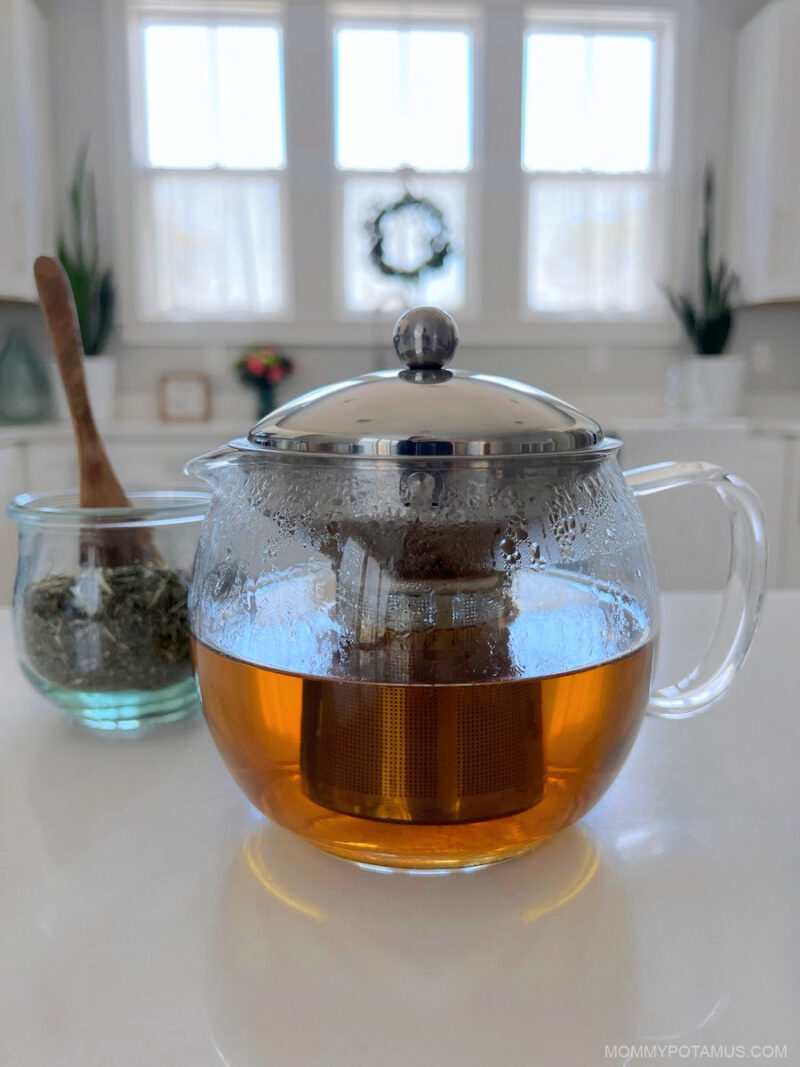
Vervain Tea Recipe
I’m going to be straight with you: Vervain is bitter. Unlike rosehip tea or other delicious infusions, this is one I gulp instead of sipping. I still drink it, though, because it truly does relax my nervous system.
If you’re drinking it for digestive support, it’s best to drink it without sweetener. (9) However, if you’re drinking it for nervous system support you may want to add a squeeze of lemon and honey to improve the flavor.
Ingredients
- 1-3 teaspoons blue vervain
- 1 cup boiling water
To Make
Pour 1 cup of boiling water over the herb, cover and infuse for 10-15 minutes. Strain out the blue vervain and sweeten to taste/add lemon if desired.
To Use
Medical Herbalism suggests taking it three times a day.
Blue Vervain Tincture Recipe
The tincture formula generally recommended for blue vervain is a 1:5 ratio (1 ounce herb by weight, 5 ounces alcohol by volume) in 40% alcohol.
Ingredients:
- 1 ounce dried blue vervain (by weight)
- 5 ounces 80 proof alcohol (40% alcohol by volume)
To Make
Pour the alcohol over the herbs, then cover the jar with a lid and shake it well. If desired, write the start date on the jar using a sticky note, label, or piece of tape – it makes keeping track of how long it’s been steeping easier.
Place the jar in a dark, room temperature area. (I keep mine in a kitchen cabinet.) Let the mixture steep for 3-4 weeks. Shake occasionally.
When the tincture is ready, use a mesh colander or cheesecloth to filter out the herbs. Pour the tincture in a clean jar or dropper bottle and store it in a cool, dark area.
To Use
The Modern Herbal Dispensatory suggests starting with 5-10 drops, and “If no results are seen, increase to 1-2 ml (0.2-0.4 tsp) up to 4 times daily.” (10)
Blue Vervain Glycerite Recipe
For individuals who want to avoid alcohol-based tinctures, glycerin-based extractions are an excellent option.
Glycerin is naturally sweet, which can help balance the bitter flavor in blue vervain. However, because it’s not as efficient as alcohol at extracting beneficial compounds, heat is needed to help things along.
Extractions made with glycerin have a relatively long shelf life of up to three years, sometimes more. (Alcohol-based tinctures will last even longer, though.) Because they are slightly less concentrated than alcohol-based tinctures, the recommended amount for use is slightly higher.
- 1 ounce dried blue vervain (by weight)
- 3.3 fluid ounces of glycerin (by volume)
- 2.7 fluid ounces purified water (by volume)
To Make
Place the glycerin, water, and blue vervain in a small pot and heat on the stovetop until simmering. Simmer for 20-30 minutes, then strain and pour into a sterilized jar. I store my glycerites in the fridge and try to use them within one year.
To Use
The Modern Herbal Dispensatory suggests “1-5 ml (0.2-1 tsp) as needed 3-4 times daily.” (10)
Bath
According to Richo Cech, author of Making Plant Medicine, strongly brewed blue vervain tea can be added to a sitz bath (shallow warm bath) to ease hemorrhoid discomfort. (9)
Safety Considerations
The Botanical Safety Handbook (2nd Edition) classifies blue vervain as a Safety Class 2b herb, which means it is not recommended for use during pregnancy. Breastfeeding is not considered a contraindication.
It has no known interactions with other medications and herbs, but there are a couple of additional cautions:
- It should not be used “in the presence of overt liver disease.” (9)
- “Large quantities may induce nausea, but its extremely bitter quality makes this issue unlikely.” (2)
Do you have a question about blue vervain? Please let me know in the comments below!
Blue Vervain Tea Recipe
Ingredients
- 1-3 tsp blue vervain
- 1 cup boiling water
Instructions
- Pour 1 cup of boiling water over the herb, cover and infused for 10-15 minutes.
- Strain out the blue vervain and sweeten to taste/add lemon if desired.
Notes
Want more research-backed natural remedies?
No problem, I’ve created a free ebook for you – Kitchen Apothecary: 25+ Natural Remedies Using Ingredients From Your Pantry – as a gift for signing up for my newsletter. You’ll also get updates when I post about safe essential oils for pregnant/breastfeeding mamas, exclusive gifts and coupons (I was able to give away a jar of free coconut oil to anyone who wanted it recently!), plus other goodies.
Sign up using the form below.
- Hutchens, Alma (1991) Indian Herbalogy of North America
- Pursell, JJ (2015) The Herbal Apothecary: 100 Medicinal Herbs and How to Use Them
- Hoffman, David (2003) Medical Herbalism
- Hoffman, David (2016) The Complete Herbs Sourcebook
- Yokosuka, Akihito et. al. (2021) Chemical Constituents of the Whole Plant of Verbena hastata and Their Inhibitory Activity Against the Production of AGEs
- Makino, Y. et. al. (2009) Hastatoside and verbenalin are sleep-promoting components in Verbena officinalis
- Akanmu, Moses et. al. (2002) Hypnotic effects of total aqueous extracts of Vervain hastata (Verbenaceae) in rats
- de la Foret, Rosalee (2017) Alchemy of Herbs: Transform Everyday Ingredients into Foods and Remedies That Heal
- Cech, Richo (2016) Making Plant Medicine
- Thomas Easley and Steven Horne (2016) The Modern Herbal Dispensatory

